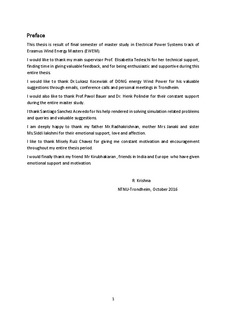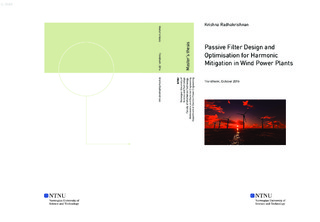| dc.description.abstract | Over exploitation of fossil fuels and ill effect of global warming has forced human civilisation in search of new sustainable energy resources. Renewable energy resources like hydro, solar, wind , biomass etc., are environmental friendly energy resources. One such renewable energy resource is Wind Energy. The growth of offshore wind farms is increasing, with it the problems associated with electrical generation.
Harmonics is one such problem faced by the Offshore Wind Power System. Harmonics are injected into the power system primarily through power electronic converters and are amplified by harmonic resonances in the power system. It is of utmost importance to electrical engineers to produce harmonic pollution less power to the customers. Harmonic mitigation structures are used to mitigate harmonic frequencies. Passive filter is one such and major harmonic frequency mitigation structure.
This thesis deals with optimization of passive filters in a wind power plant. The objective of the thesis is to analyse harmonics that are present in the wind power system, design passive filters to eliminate or control the harmonic distortions and optimize these filters on various and possible parameters.
A test case system Anholt Offshore Wind Farm was taken into consideration and the wind power system was modelled in MATLAB Simulink. The harmonics present in the system was analysed. LCL filter was designed to mitigate harmonic frequencies and optimization of LCL filter components on factors like attenuation factor, acceptable total and individual voltage and current harmonic distortion, fundamental frequency losses and reactive power capability was conducted. The optimum LCL filter parameters was found out to give acceptable total harmonic distortion of voltage waveform dictated by IEC standards.
Further modelling and design second order high pass filter, third order high pass filter, C-Type filter, Switching frequency trap filter, C-Type with switching frequency trap filter and resonance trap filter were designed and modelled in the simulation platform. Optimization of all these filters was conducted based on quality factor, acceptable total and individual voltage harmonic distortion dictated by IEC standards, fundamental frequency losses and reactive power capability. The results of the optimized filter was tabulated an it was found that C-Type filter with switching frequency trap filter gave the optimum results. All these filter design was conducted at wind turbine level.
At wind farm level reactive power compensation was established, harmonic distortion monitoring and harmonic resonance monitoring was done, and the result show that C-Type with witching frequency trap filter gave the optimum results. It can also be seen that different passive filters operate more efficiently at different harmonic frequency ranges. | |

